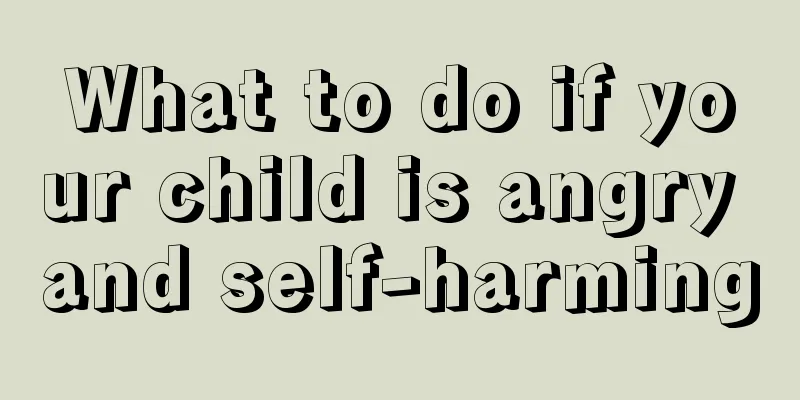What to do if a one-year-old child has a fever

|
Many young parents have encountered relatively few things, and when they encounter unexpected situations, they may not know how to deal with them. It is common for children to have a fever. What should you do if a one-year-old child has a fever? First of all, parents should understand the cause of the baby's fever, and then use physical cooling methods to reduce the baby's fever as soon as possible. Let's learn about the details together. 1. 1-year-old baby has a fever 1. Most babies have fevers because of catching a cold. If the baby has cold hands and feet, white tongue coating, pale face, and light urine during the fever, parents can use ginger and brown sugar water to dispel the cold. Adding two or three one-inch long pieces of green onion to the water will help the baby sweat. 2. If the baby has a fever, sore throat, yellow tongue coating, and yellow urine with a strong odor, it means that the child has severe internal heat. At this time, he cannot drink ginger and sugar water, but should drink plenty of warm boiled water. You can also add a small amount of salt to the water. Adults should not be too nervous when the baby has a fever. This is also one of the ways for the baby's body to regulate itself. Don't rush to use antipyretics to reduce fever, as this can easily mask some of your baby's symptoms. The baby is hot-tempered, may be listless and make a fuss. Play with the baby more, take care of him/her more patiently, and don't panic. 3. If the fever does not exceed 38.5 degrees, you can use physical cooling methods, wipe the whole body with a warm towel, or give the baby a bath with the water temperature below 37 degrees. Be careful not to let the baby catch a cold when coming out of the water. Wrap the baby with a bath towel in time, and wipe the palms and soles of the feet with alcohol. If the temperature exceeds 38.5 degrees, you should seek medical attention immediately to avoid other chain reactions. Tests and examinations can also help find the real cause (for example, there are bacterial and viral colds, and the medications are completely different. The diagnosis and treatment methods for fever should also be different. Don't be afraid of antibiotics and avoid seeing a doctor, so as not to delay your baby's death). 2. What should a 1-year-old baby eat when he has a fever? When your baby has a fever, it is suitable to eat small meals frequently, mainly light, easily digestible liquid or semi-liquid food. Nutritional complementary food is a good choice. So what kind of nutritional complementary food should be supplemented? First of all, we should know that when the baby has a fever, the metabolism speeds up, the consumption of nutrients increases greatly, and the consumption of water in the body also increases significantly. At the same time, when you have a fever, the secretion of digestive juices decreases, gastrointestinal motility slows down, and the digestive function is significantly weakened. Therefore, it is very necessary to supply sufficient water, supplement a large amount of vitamins and inorganic salts, and provide an appropriate amount of calories and protein. However, the diet should be mainly liquid and semi-liquid food, so that it is easier to digest. Below is a detailed introduction to several easy-to-make nutritious complementary foods. First, rice soup. The method is to boil the rice, remove the residue, and add a little white sugar. Rice soup is rich in water and easy to digest and absorb. Second, egg custard. The method is to beat 2 eggs, add appropriate amount of warm water and steam them before eating. Egg custard can supplement protein and is easier to digest and absorb, but you should not eat too much, especially babies with coughs should not eat eggs. Third, watermelon juice. The method is even simpler. Remove the seeds and cut the watermelon into pieces, then put it into a food processor and blend it into juice. Watermelon juice has the effects of clearing heat, relieving summer heat and acting as a diuretic, and can promote the excretion of toxins. Fourth, fresh pear juice. The method is the same as watermelon juice. Now is the season when pears are in season. You can make some fresh pear juice to supplement vitamins for your baby. Fresh pear juice has the effects of clearing heat, moistening the lungs and relieving cough. It is suitable for children with fever and cough. Fifth, fresh apple juice. The method is the same as watermelon juice. The reason for supplementing with apple juice is that it contains a large amount of vitamin C, which can supplement the body's nutritional needs and neutralize toxins in the body. However, the above complementary foods should be fed to the baby only when the baby is willing to eat them. If the baby dislikes them, you can adopt the method of feeding small amounts and multiple meals. But no matter what you do, make sure your baby gets plenty of water. |
<<: What medicine should a three-year-old baby take for fever
>>: Why does drinking milk powder cause internal heat?
Recommend
What are the symptoms and treatments of food indigestion in children?
Indigestion in young children is a relatively com...
Will the baby's temperature rise after feeding?
There are two situations when babies drink milk: ...
What are the symptoms of flu in children?
Influenza is a very common illness. Generally spe...
Why does my 2-year-old baby snore?
We also know that baby's sleep is very import...
Treatment of crooked neck in newborn
Nowadays, examples of newborns with crooked necks...
What causes yellow palms in children?
Although Asians generally have yellow skin, the p...
What causes a newborn's loud breathing?
Many newborns have very loud breathing sounds, wh...
The best age for women to have children
In modern society, many female friends always get...
What is the world like for children with autism?
The world of autistic children is dark. They have...
How long will it take for baby's eyelids to get better?
For new parents, they all hope that their baby wi...
What should children with alopecia areata eat?
In today's life, the incidence of diseases is...
Baby sweats on back when sleeping at night
New mothers will encounter this problem. Babies s...
What is normal for children's fasting blood sugar?
Many people don't know much about how high a ...
What is the cause of a three-year-old child's headache?
Some children often feel headaches. We must pay a...
How to care for newborns with viral colds
Because newborns have just left their mother'...









